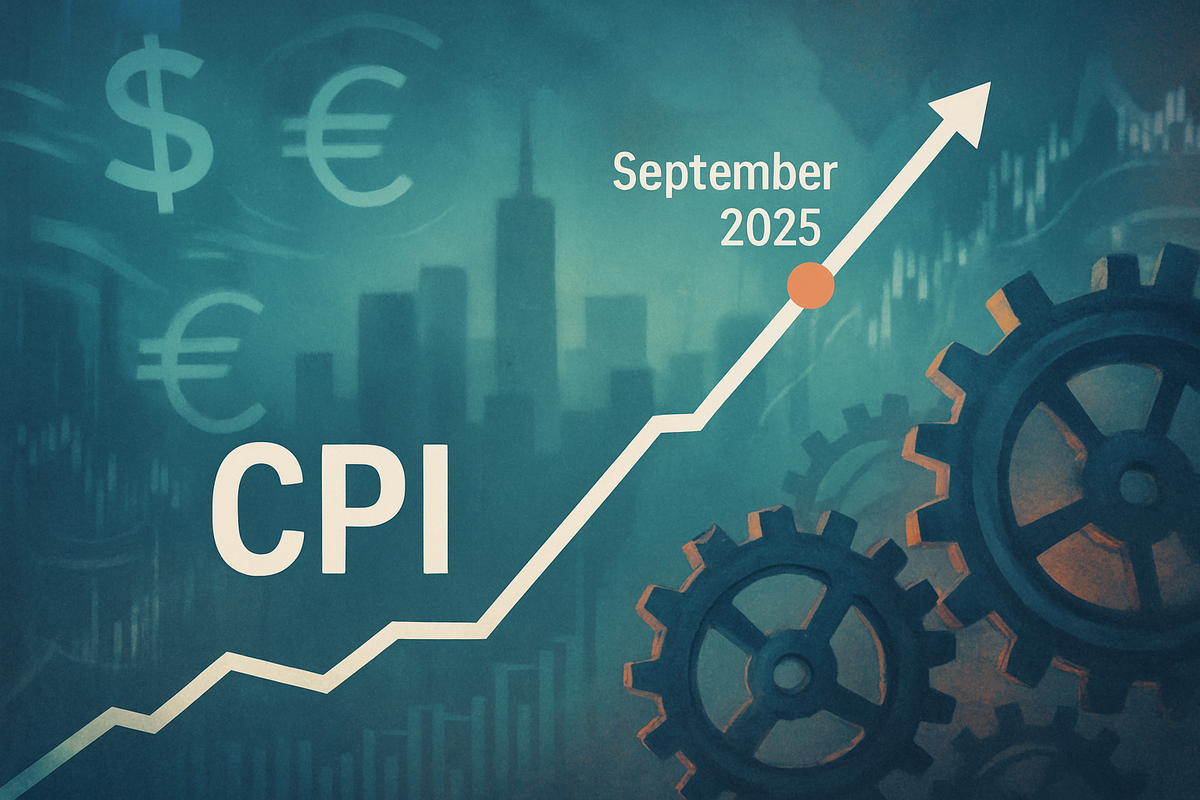
The highly anticipated Consumer Price Index (CPI) report for September 2025, slated for release on Friday, October 24, 2025, is poised to be a pivotal moment for the US economy, the Federal Reserve's monetary policy, and investor sentiment. Coming amidst a period of limited economic data due to a recent government shutdown, this inflation gauge is expected to reveal persistent price pressures, challenging the Federal Reserve's delicate balancing act between taming inflation and supporting a softening labor market.
Economists are keenly awaiting the figures, which will provide a critical update on the trajectory of inflation, a key determinant of consumer purchasing power, corporate profitability, and the future path of interest rates. The report's outcome will not only shape immediate market reactions but also cast a long shadow over the economic outlook for the remainder of 2025 and into 2026.
The CPI Report: A Deep Dive into Inflationary Pressures
The CPI report for September 2025, which measures the average change over time in prices paid by urban consumers for a basket of goods and services, was initially scheduled for October 15 but was delayed due to a U.S. government shutdown. The Bureau of Labor Statistics (BLS) will now release this crucial data on Friday, October 24, 2025, at 8:30 AM Eastern time. This delay has only amplified its significance, as it offers one of the few recent official glimpses into the nation's economic health.
Market analysts, including those surveyed by Bloomberg, anticipate the headline CPI to have climbed around 0.3% to 0.4% month-over-month, pushing the annual headline inflation rate to approximately 3.0% to 3.1%. If realized, this would mark the highest annual inflation rate since May 2024. The more closely scrutinized core CPI, which strips out volatile food and energy prices to reveal underlying inflationary trends, is generally forecast to have risen around 0.3% month-over-month, keeping its annual rate steady at roughly 3.0% to 3.1%. These figures underscore a continued battle against inflation, which remains stubbornly above the Federal Reserve's long-term 2% target.
Key players closely monitoring this report include the Federal Reserve, which uses CPI data to inform its monetary policy decisions, particularly on interest rates. Economists from both private and public sectors will dissect the data, providing analysis and forecasts that guide investors in adjusting their portfolios across stocks, bonds, and commodities. Government departments, notably the Social Security Administration, also rely on September's CPI-W (CPI for Urban Wage Earners and Clerical Workers) to calculate the annual Cost-of-Living Adjustment (COLA) for federal benefits.
Initial market reactions are expected to be significant. A survey indicates that 45% of investors anticipate a "risk-on" market reaction if the CPI aligns with or comes in cooler than expectations, validating the market's current anticipation of Federal Reserve rate cuts. This scenario could lead to a relief rally in risk assets and lower bond yields. Conversely, a hotter-than-expected CPI print could trigger a "risk-off" sentiment, causing substantial downside risk in markets, driving bond yields higher, and challenging the prevailing narrative of impending rate cuts, particularly impacting growth and technology sectors. This data is considered crucial because of the ongoing "economic data blackout" caused by the government shutdown, making it a rare and vital source of information for assessing the U.S. economy's current state.
Corporate Contenders: Who Wins and Loses from Inflation's Grip
The outcome of the September 2025 CPI report will reverberate across various sectors of the U.S. economy, creating distinct winners and losers depending on whether inflation surprises to the upside or downside. Companies' ability to manage rising input costs, maintain pricing power, and adapt to changing consumer spending habits will be paramount.
Should the CPI report indicate higher-than-expected inflation, sectors with strong pricing power and those that benefit from rising commodity prices are likely to fare better. Energy companies, such as ExxonMobil (NYSE: XOM) and Chevron (NYSE: CVX), often see increased revenues and profits as higher oil and gas prices contribute to overall inflation. Similarly, Materials sector giants like Rio Tinto (NYSE: RIO) and Freeport-McMoRan (NYSE: FCX) can benefit as the value of raw materials rises. Financial institutions like JPMorgan Chase & Co. (NYSE: JPM) and Bank of America Corp (NYSE: BAC) might also see increased net interest margins if higher inflation prompts the Federal Reserve to maintain or raise interest rates. Conversely, Technology and Growth stocks, exemplified by NVIDIA Corp. (NASDAQ: NVDA) and Tesla Inc. (NASDAQ: TSLA), are highly sensitive to rising interest rates, which increase their borrowing costs and reduce the present value of their future earnings, making them less attractive. Consumer Discretionary companies, including Starbucks Corp. (NASDAQ: SBUX) and Nike Inc. (NYSE: NKE), could see reduced demand as inflation erodes consumer purchasing power.
Conversely, a lower-than-expected CPI report, signaling easing inflationary pressures or even disinflation, would likely benefit rate-sensitive sectors. Technology and Growth stocks like Microsoft Corp. (NASDAQ: MSFT) and Amazon.com Inc. (NASDAQ: AMZN) would likely surge as lower interest rates reduce borrowing costs and enhance the present value of their future earnings. The Consumer Discretionary sector, including retailers such as Lowe's Companies Inc. (NYSE: LOW), and Homebuilders like D.R. Horton Inc. (NYSE: DHI) and Lennar Corp. (NYSE: LEN), would see a boost from increased consumer purchasing power and potentially lower mortgage rates. Regional banks, such as Capital One Financial Corp. (NYSE: COF), could also benefit from a more accommodative monetary policy that stimulates lending activity. In this scenario, sectors like Energy and Materials might face headwinds if lower inflation signals softening commodity demand.
If the CPI report largely meets expectations, the immediate market reaction would likely be muted, with investors focusing on individual company fundamentals rather than broad macroeconomic shifts. However, even with in-line inflation, subtle shifts in the sub-components of the CPI, such as persistent shelter inflation, could still have targeted impacts on related sectors and pressure the Federal Reserve to maintain a cautious stance. Companies across all sectors are thus compelled to continuously refine their strategies for cost management, supply chain resilience, and strategic pricing to navigate this dynamic economic landscape.
Beyond the Numbers: Wider Economic and Policy Ramifications
The September 2025 CPI report's significance extends far beyond immediate market fluctuations, embedding itself deeply within broader industry trends, regulatory frameworks, and historical economic parallels. It serves as a crucial barometer for the underlying health of the US economy, particularly concerning the persistence of inflation and its implications for growth.
The report arrives at a time when global economic growth is projected to slow, with the US facing unique challenges where inflation risks remain tilted to the upside, largely due to the impact of tariffs. These tariffs, described as the highest since pre-World War II, have been a significant driver of goods price increases, affecting industries reliant on imported components such as apparel, furniture, and sporting goods. Businesses in these sectors face the difficult choice of absorbing higher costs, thus squeezing profit margins, or passing them on to consumers, potentially dampening demand. This dynamic can create ripple effects, impacting competitors and partners across global supply chains who may face increased uncertainty and pressure to find alternative sourcing.
From a regulatory and policy perspective, the CPI report is paramount for the Federal Reserve. Despite persistent inflation above its 2% target, the Fed is widely expected to cut interest rates by 25 basis points at its upcoming October meeting, with another cut potentially in December. This reflects a growing concern for the softening labor market. However, a significantly hotter-than-expected CPI could force the Fed to reconsider or delay these anticipated cuts, complicating its efforts to achieve a "soft landing." Furthermore, the CPI data directly influences government fiscal measures, including the annual cost-of-living adjustments for Social Security benefits, with the 2026 COLA expected to be around 2.7%, impacting millions of Americans.
Historically, the current economic climate draws comparisons to periods where central banks have grappled with balancing inflation control and economic growth. The Fed's current dilemma echoes past challenges of taming inflation without stifling economic activity, a trade-off seen in various cycles of monetary tightening and easing. The impact of tariffs on consumer prices also mirrors historical instances where import taxes have led to increased costs for consumers, forcing businesses to adapt by front-loading inventories or seeking alternative suppliers. The report will further inform the ongoing debate about whether current inflation trends are temporary or indicative of a more persistent issue, especially as tariff costs continue to filter through to consumers.
Navigating the Future: What Lies Ahead for Markets and Policy
The aftermath of the September 2025 CPI report will shape both short-term market movements and long-term strategic planning for businesses and policymakers. Depending on the inflation figures, distinct scenarios with varying implications will unfold.
In the short term, if the CPI report signals higher-than-expected inflation, financial markets are likely to experience immediate declines, with technology stocks potentially facing stronger selling pressure. Bond yields would rise, and the U.S. dollar could strengthen, as expectations for tighter monetary policy from the Federal Reserve gain traction. Conversely, a cooler-than-expected CPI would likely trigger market gains, especially in growth and consumer-oriented sectors, with bond yields falling and the U.S. dollar potentially weakening. Policymakers would respond by either reinforcing a hawkish stance to control inflation or embracing a more dovish approach to stimulate economic growth.
Long-term, persistent high inflation could lead to slower economic growth as diminished purchasing power curbs consumer spending and business investment. Businesses would need to prioritize cost efficiency, diversify supply chains, and implement strategic pricing. Policymakers would likely maintain a hawkish stance, potentially leading to a prolonged period of higher interest rates. Conversely, a sustained period of low and stable inflation, coupled with accommodative monetary policy, could foster robust economic growth, shifting business focus towards expansion and innovation. Policymakers would aim for price stability while supporting growth.
Regardless of the immediate outcome, businesses and policymakers face critical strategic pivots and adaptations. For businesses, this means enhanced financial planning and analysis, prioritizing supply chain resilience through diversification, and adopting creative pricing strategies beyond blanket increases. Rigorous cost management, product portfolio streamlining, and adapting talent management to rising labor costs will also be crucial. Policymakers, particularly central banks, will need to maintain a data-dependent monetary policy, ensuring clear communication to manage market expectations. Coordination between fiscal and monetary policies will be essential to balance economic support with inflation control, while also addressing underlying structural issues contributing to price pressures. These adaptations are vital to navigate the emerging market opportunities or challenges, ensuring resilience and long-term success in an evolving economic landscape.
The Road Ahead: A Comprehensive Market Outlook
The September 2025 CPI report, released on October 24, 2025, serves as a critical juncture for understanding the trajectory of inflation and its profound implications for the U.S. economy and financial markets. The key takeaway from the anticipated figures is the continued, albeit moderate, rise in both headline and core inflation, driven by factors such as elevated tariffs and sticky services inflation. This persistence above the Federal Reserve's 2% target underscores the ongoing challenge policymakers face.
Moving forward, the market's assessment appears to be one of cautious optimism, with a "risk-on" sentiment prevailing among investors who anticipate the Federal Reserve will proceed with interest rate cuts despite the stubborn inflation. Financial markets are pricing in a near-certainty of a 25 basis point rate cut by the Fed at its upcoming October meeting, with further easing expected in December. This outlook is largely influenced by the Fed's perceived focus on a softening labor market. However, a significantly hotter-than-expected CPI could abruptly shift this narrative, potentially delaying or even halting the anticipated rate cuts, leading to increased market volatility.
The lasting impact of this CPI report will be its influence on the ongoing inflation debate and the Federal Reserve's monetary policy path. It will also directly affect millions of Americans through the 2026 Social Security cost-of-living adjustment, expected to be around 2.7%. Investors in the coming months should prioritize monitoring core CPI and services inflation, as these are key indicators for the Fed. Close attention to Federal Reserve communications will be paramount to understanding their evolving stance on inflation and future interest rate policy. Analyzing the specific components driving inflation, evaluating labor market data, and assessing broader economic growth trends will provide a more comprehensive picture. In an environment characterized by sticky inflation, potential policy shifts, and moderating growth, maintaining a well-diversified portfolio and emphasizing high-quality assets will be crucial for navigating the market's complexities. The actual CPI data for October 2025, due in mid-November, will be the next significant data point to watch, building upon the trends established by this critical September report.
This content is intended for informational purposes only and is not financial advice





